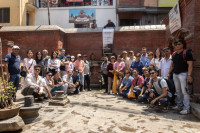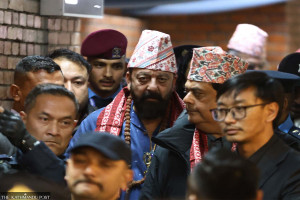Culture & Lifestyle
Answering the call of the mountains
A trip to Everest Base Camp in 2017 kindled Purnima Shrestha’s love for the mountains. But unlike most people, she took this love much further by climbing seven of Nepal’s tallest mountains in just five years.
Pinki Sris Rana
A few weeks ago, Purnima Shrestha made it to the headlines for climbing three eight-thousand metre peaks within three months. With this mountaineering milestone, Shrestha became one of the few Nepali women climbers to summit all seven eight-thousander peaks in the country.
What makes Shrestha’s story as a mountaineer unique is that until 2017, mountaineering was something that was not even remotely part of her imagination. But things shifted in 2017 when she got an opportunity to travel to Everest Base Camp to cover the Tenzing Hillary Everest Marathon 2017 for Karobar, a national economic daily where she continues to work as a photojournalist.
“Unlike many people, I didn’t trek all the way to Everest Base Camp. Instead, I flew there directly, which meant I didn’t get the time necessary to acclimatise to the high altitude, and I ended up experiencing altitude sickness,” says Shrestha. “But everything became worth it when I saw Everest for the first time. This trip just made me fall in love with the mountains.”
Once back in Kathmandu, Shrestha started telling people that she would climb Everest one day, but nobody took her seriously. For the next year, Shrestha made it a point to take the time to meet a lot of mountaineers to understand what it takes to climb Everest. One day, someone suggested that she start by climbing Manaslu, a mountain she had grown up hearing a lot about.
As someone who was born and raised in Aarughat, Gorkha (the gateway to the popular Manaslu circuit trek), Shrestha had grown up seeing trekkers and mountaineers head to Manaslu. As a child, she had even sold lettuces to many of these trekkers and mountaineers. Beginning her newly developed passion for mountaineering by summiting Manaslu made sense to her.
But summiting a mountain like Manaslu is an expensive affair, and Shrestha didn’t have the funds needed to pull off the expedition. Not the one to let her financial strength keep her away from following her mountaineering dreams, she started collecting funds from her circle of friends, and when the money still fell short, she took a loan, which Shrestha says, she is still paying off.
With funds taken care of, Shrestha joined a Manaslu expedition with the bare minimum physical and mountaineering training required.
“It was only when the expedition finally began that I realised how physically and mentally tough the expedition would be and why everyone thought I wouldn’t be able to do it. But this realisation made me more determined than ever to summit Manaslu,” says Shrestha.
While others in the expedition only carried basic essentials during the summit push, Shrestha went all the way to the summit and back by carrying four kgs of camera gear in her backpack. The photographer in her desperately wanted to document the expedition. But the decision to lug all that camera gear, says Shrestha, made the expedition much more challenging.
“I was a novice climber and didn’t know how tough it was going to be to climb such a technical mountain with all that extra weight on my back. It wasn’t a practical thing to do," smiles Shrestha.
That was the last time Shrestha summited a mountain with her camera gear. After that experience, she would only take the camera gears only upto the base camp.
The Manaslu expedition, says Shrestha, made her realise how risky mountaineering is. When she felt overwhelmed thinking about all the risks involved, Shrestha questioned her passion for mountaineering and wondered why her parents did not stop her from embarking on the journey.
“The expedition tested me immensely, but I feel fortunate that the Sherpa that was assigned to me always kept on motivating and encouraging me,” says Sherpa.
The same year Shrestha summited Manaslu, she also climbed Everest. Then in 2021, she summited Annapurna I and Dhaulagiri. In May 2022, she summited Kanchenjunga, Lhotse, and Makalu. In the five years that Shrestha has dedicated herself to climbing, she says she has seen firsthand the vital role Sherpas play in making expeditions safe and successful.
From fixing ropes and ladders on the mountains to setting up camps and guiding climbers and rescuing them if need be, Sherpas are the backbone of Nepal’s mountaineering industry.
Shrestha’s appreciation for the instrumental role Sherpas plays in mountaineering expeditions is evident in the way she speaks about them.
“Sherpas put their own lives at risk to assist people in realising their mountaineering dreams,” says Shrestha. “I cannot thank them enough for all that they have done in helping me realise my dream. After all, climbing mountains was my dream, not theirs.”
When asked what has been the most challenging thing for her in her mountaineering journey so far, Shrestha has a ready answer “collecting funds”.
To fund Shrestha’s Everest expedition, each student from Bhimodaya school, the school she went to in Gorkha, contributed Rs 5 each. Shrestha even reached out to local governments of Gandaki Province and prominent business houses in Kathmandu to fund her other expeditions. While many think it becomes much easier for climbers to get sponsors once they have climbed Everest, Shrestha says that it's not the case, at least for Nepali female climbers. Even after Shrestha summited Everest in April 2018, she still came across many people who questioned her credibility in the mountaineering field.
But things, she says, improved a little after April of 2021, the year she became one of the first women to climb Annapurna I. The Annapurna summit made people take her a bit more seriously as a mountaineer. Despite her impressive mountaineering achievements in a relatively short period of time, Shrestha says that finding sponsors to fund her expeditions is still very challenging.
Shrestha thinks one of the reasons for that has to do with her being a woman and her physical appearance.
“As a woman with a diminutive physical frame, many sponsors don’t think I fit the bill of what a mountaineer ought to look like, and they immediately second guess my ability,” says Shrestha. “I might not be the strongest mountaineer out there, but I’m definitely the most passionate one, and I didn't come all the way to where I am today to just give up on my dreams.”




 6.3200000000001°C Kathmandu
6.3200000000001°C Kathmandu















